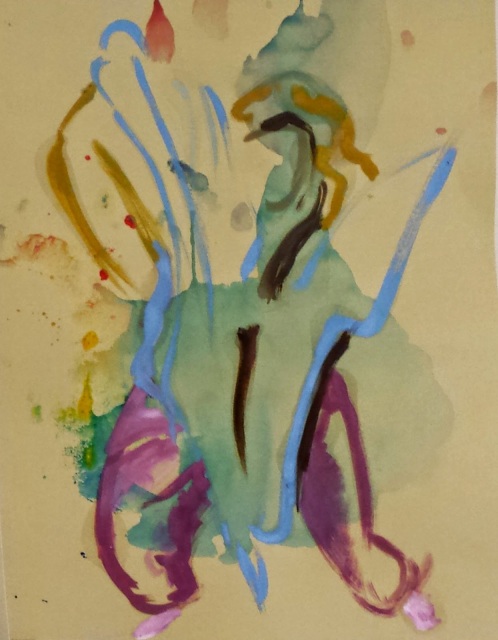I have always worked in series for a variety of reasons (drying time, being prolific, collecting imagery) and now this becomes even more important with the ‘pages’ in my practice. My latest version of artist statement states in the last paragraph…
By working on multiple surfaces and in series, I play with chronology and manifestations of the book. Every encounter with the ‘pages’ generates an alternative dialogue where chance elements come together to build their own narrative, creating different versions of truth within the imaginary painted space. I am interested in the process of re-reading and re-tracing and how this allows us to create narrative based on stories which shape our experience. This is developed through the use of line, shadow, stain and trace of my figures in their environments.
I have chosen five pieces so far which fit within this series entitled Trace Dance. There is other work to include but these all capture the use of line, shadow, stain and trace. I have been playing with the idea of trace for quite a long time – in fact it was one of the priorities I outlines in my Final Project proposal, although in the guise of shadow and reflection. The dance refers to the movement and interaction between the figures, each other and their environment. After creating this title, I discovered an article http://ro.uow.edu.au/currentnarratives/vol1/iss3/5/ by Julia Prendergast called ‘Discontinuous Narrative: The Trace Dance’ where she writes about…
‘This paper explores Derrida’s concept of alterity: specifically the ‘trace’ of ‘otherness’, as it corresponds to presence (Rivkin & Ryan 2004, p.278). I call this trace of otherness: The Trace Dance, because of the way alterity operates in discontinuous narrative. The playoff between the narrators’ voices occurs in the shadowy place: in the realm of alterity.’
I find it amazing that I was generating a title and through that discovered a paper which seems to link with my reading of Arthur Frank’s ‘Letting Stories Breathe’. A perfect connection and something which may add to my research and writing. Now that I am letting my research drive my making, it is good to see how the making then also finds references itself. My usual method is to read then research names and text which are refered to within the body of writing.
So if we consider my pages as a discontinuous narrative, they may act as versions of a story in an alternative time or place. Section from my statement…
My most recent work continues a series exploring alternate truths where I am investigating the relationship between aesthetics and concept; parallels between making and ideas. These paintings introduce a sense of deconstruction and disorder. Figures begin to merge and blend with each other and their environment, challenging the boundaries of the body, which recedes and disappears within the picture plane. The gestural use of colour aims to suggest both energy, generated by movement or touch, and a means of obliteration.
Chosen pieces:
 |
| Oil on canvas – experimentation with underpainting (lime), negative space and obliteration – like the diagonal composition and white legs |
 |
| A3 prep using printing ink and oil on paper – very loose simplistic use of line and almost whole surface of turquoise stain |
 |
| Printing ink and oil on canvas – love the stain at contact point of the two bodies. Think left set of legs need refining or perhaps obliterating. |
 |
| Printing ink and oil on canvas – more use of stains to obliterate and reintroduction of negative space (white arm) – like the simplification in some areas to just line |
Reflection
I feel better about my progress when I am able to curate and emerging series of work. These pieces could work together in a gallery setting and certainly reflect the journey of making and ideas I have been on during the unit and in fact the MA. The challenge for me now is going to be to keep pushing the practical element to make a body of show ready work using similar techniques and incorporating the action/concept mark making and colour palettes which I have yet to do.
One Month Reflection
This decision to work in series hugely influenced the development of both my practical work and contextual study. In fact, these pieces were the starting point but not all eventually part of Trace Dance 1.1 – 1.8 which I have made during the last stage of the final project. The visual characteristics have remained the same and each piece continues to hold its own identity within the series, however, the works are tied by media (acrylic on canvas), partial figures, movement and physical gesture.


I love the energy that comes from your paintings! Keep up the good work! 🙂